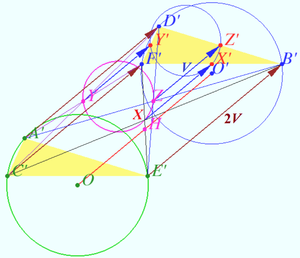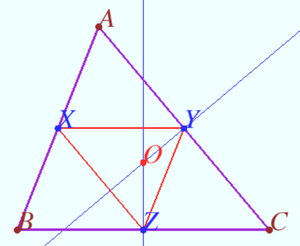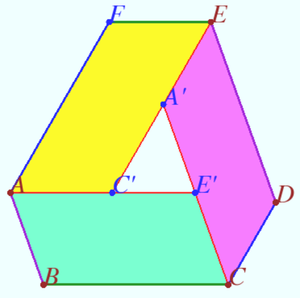Difference between revisions of "2021 USAMO Problems/Problem 6"
(→Solution) |
|||
| (One intermediate revision by one other user not shown) | |||
| Line 2: | Line 2: | ||
Let <math>ABCDEF</math> be a convex hexagon satisfying <math>\overline{AB} \parallel \overline{DE}</math>, <math>\overline{BC} \parallel \overline{EF}</math>, <math>\overline{CD} \parallel \overline{FA}</math>, and<cmath>AB \cdot DE = BC \cdot EF = CD \cdot FA.</cmath>Let <math>X</math>, <math>Y</math>, and <math>Z</math> be the midpoints of <math>\overline{AD}</math>, <math>\overline{BE}</math>, and <math>\overline{CF}</math>. Prove that the circumcenter of <math>\triangle ACE</math>, the circumcenter of <math>\triangle BDF</math>, and the orthocenter of <math>\triangle XYZ</math> are collinear. | Let <math>ABCDEF</math> be a convex hexagon satisfying <math>\overline{AB} \parallel \overline{DE}</math>, <math>\overline{BC} \parallel \overline{EF}</math>, <math>\overline{CD} \parallel \overline{FA}</math>, and<cmath>AB \cdot DE = BC \cdot EF = CD \cdot FA.</cmath>Let <math>X</math>, <math>Y</math>, and <math>Z</math> be the midpoints of <math>\overline{AD}</math>, <math>\overline{BE}</math>, and <math>\overline{CF}</math>. Prove that the circumcenter of <math>\triangle ACE</math>, the circumcenter of <math>\triangle BDF</math>, and the orthocenter of <math>\triangle XYZ</math> are collinear. | ||
| − | ==Solution== | + | ==Solution 1== |
| + | Let <math>M_1</math>, <math>M_2</math>, and <math>M_3</math> be the midpoints of <math>CE</math>, <math>AE</math>, <math>AC</math> and <math>N_1</math>, <math>N_2</math>, and <math>N_3</math> be the midpoints of <math>DF</math>, <math>BF</math>, and <math>BD</math>. Also, let <math>H</math> be the orthocenter of <math>XYZ</math>. Note that we can use parallel sides to see that <math>X</math>, <math>Z</math>, and <math>M_3</math> are collinear. Thus we have <cmath> \text{Pow}(M_3,(XYZ)) = M_3Z \cdot M_3X = \frac 14 AB \cdot DE </cmath> by midlines. Applying this argument cyclically, and noting the condition <math>AB \cdot DE = BC \cdot EF = CD \cdot FA</math>, <math>M_1</math>, <math>M_2</math>, <math>M_3</math>, <math>N_1</math>, <math>N_2</math>, <math>N_3</math> all lie on a circle concentric with <math>(XYZ)</math>. | ||
| + | |||
| + | Next, realize that basic orthocenter properties imply that the circumcenter <math>O_1</math> of <math>(ACE)</math> is the orthocenter of <math>\triangle M_1M_2M_3</math>, and likewise the circumcenter <math>O_2</math> of <math>(BDF)</math> is the orthocenter of <math>\triangle N_1N_2N_3</math>. | ||
| + | |||
| + | The rest is just complex numbers; toss on the complex plane so that the circumcenter of <math>\triangle XYZ</math> is the origin. Then we have <cmath> o_1 = m_1+m_2+m_3 = (c+e)/2+(a+e)/2+(a+c)/2=a+c+e </cmath> <cmath> o_2 = n_1+n_2+n_3 = (b+d)/2+(d+f)/2+(b+f)/2=b+d+f </cmath> <cmath> h = x+y+z = (a+d)/2+(b+e)/2+(c+f)/2=(a+b+c+d+e+f)/2.</cmath> | ||
| + | Note that from the above we have <math>h=\frac{o_1+o_2}{2}</math>, so <math>H</math> is the midpoint of segment <math>O_1O_2</math>. In particular, <math>H</math>, <math>O_1</math>, and <math>O_2</math> are collinear, as required. | ||
| + | |||
| + | ~ Leo.Euler | ||
| + | ==Solution 2== | ||
[[File:2021 USAMO 6b.png|300px|right]] | [[File:2021 USAMO 6b.png|300px|right]] | ||
[[File:2021 USAMO 6c.png|300px|right]] | [[File:2021 USAMO 6c.png|300px|right]] | ||
| Line 40: | Line 49: | ||
'''vladimir.shelomovskii@gmail.com, vvsss''' | '''vladimir.shelomovskii@gmail.com, vvsss''' | ||
| + | |||
| + | {{MAA Notice}} | ||
Latest revision as of 23:26, 22 May 2023
Problem 6
Let ![]() be a convex hexagon satisfying
be a convex hexagon satisfying ![]() ,
, ![]() ,
, ![]() , and
, and![]() Let
Let ![]() ,
, ![]() , and
, and ![]() be the midpoints of
be the midpoints of ![]() ,
, ![]() , and
, and ![]() . Prove that the circumcenter of
. Prove that the circumcenter of ![]() , the circumcenter of
, the circumcenter of ![]() , and the orthocenter of
, and the orthocenter of ![]() are collinear.
are collinear.
Solution 1
Let ![]() ,
, ![]() , and
, and ![]() be the midpoints of
be the midpoints of ![]() ,
, ![]() ,
, ![]() and
and ![]() ,
, ![]() , and
, and ![]() be the midpoints of
be the midpoints of ![]() ,
, ![]() , and
, and ![]() . Also, let
. Also, let ![]() be the orthocenter of
be the orthocenter of ![]() . Note that we can use parallel sides to see that
. Note that we can use parallel sides to see that ![]() ,
, ![]() , and
, and ![]() are collinear. Thus we have
are collinear. Thus we have ![]() by midlines. Applying this argument cyclically, and noting the condition
by midlines. Applying this argument cyclically, and noting the condition ![]() ,
, ![]() ,
, ![]() ,
, ![]() ,
, ![]() ,
, ![]() ,
, ![]() all lie on a circle concentric with
all lie on a circle concentric with ![]() .
.
Next, realize that basic orthocenter properties imply that the circumcenter ![]() of
of ![]() is the orthocenter of
is the orthocenter of ![]() , and likewise the circumcenter
, and likewise the circumcenter ![]() of
of ![]() is the orthocenter of
is the orthocenter of ![]() .
.
The rest is just complex numbers; toss on the complex plane so that the circumcenter of ![]() is the origin. Then we have
is the origin. Then we have ![]()
![]()
![]() Note that from the above we have
Note that from the above we have ![]() , so
, so ![]() is the midpoint of segment
is the midpoint of segment ![]() . In particular,
. In particular, ![]() ,
, ![]() , and
, and ![]() are collinear, as required.
are collinear, as required.
~ Leo.Euler
Solution 2
We construct two equal triangles, prove that triangle ![]() is the same as medial triangle of both this triangles. We use property of medial triangle and prove that circumcenters of constructed triangles coincide with given circumcenters.
is the same as medial triangle of both this triangles. We use property of medial triangle and prove that circumcenters of constructed triangles coincide with given circumcenters.
Denote ![]()
![]() Then
Then ![]()
Denote ![]()
Similarly we get ![]()
![]()
The translation vector maps ![]() into
into ![]() is
is ![]()
![]()
so ![]() is midpoint of
is midpoint of ![]() and
and ![]() Symilarly
Symilarly ![]() is the midpoint of
is the midpoint of ![]() and
and ![]() is the midpoint of
is the midpoint of ![]() and
and ![]()
![]() is the midpoint of
is the midpoint of ![]()
Similarly ![]() is the midpoint of
is the midpoint of ![]() is the midpoint of
is the midpoint of ![]()
Therefore ![]() is the medial triangle of
is the medial triangle of ![]()
![]() is
is ![]() translated on
translated on ![]()
It is known (see diagram) that circumcenter of triangle coincide with orthocenter of the medial triangle. Therefore orthocenter ![]() of
of ![]() is circumcenter of
is circumcenter of ![]() translated on
translated on ![]()
It is the midpoint of segment ![]() connected circumcenters of
connected circumcenters of ![]() and
and ![]()
According to the definition of points ![]() quadrangles
quadrangles ![]() and
and ![]() are parallelograms. Hence
are parallelograms. Hence
![]()
![]() Power of points A,C, and E with respect circumcircle
Power of points A,C, and E with respect circumcircle ![]() is equal, hence distances between these points and circumcenter of
is equal, hence distances between these points and circumcenter of ![]() are the same. Therefore circumcenter
are the same. Therefore circumcenter ![]() coincide with circumcenter
coincide with circumcenter ![]()
Similarly circumcenter of ![]() coincide with circumcenter of
coincide with circumcenter of ![]()
vladimir.shelomovskii@gmail.com, vvsss
The problems on this page are copyrighted by the Mathematical Association of America's American Mathematics Competitions. 












